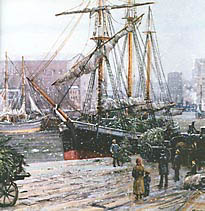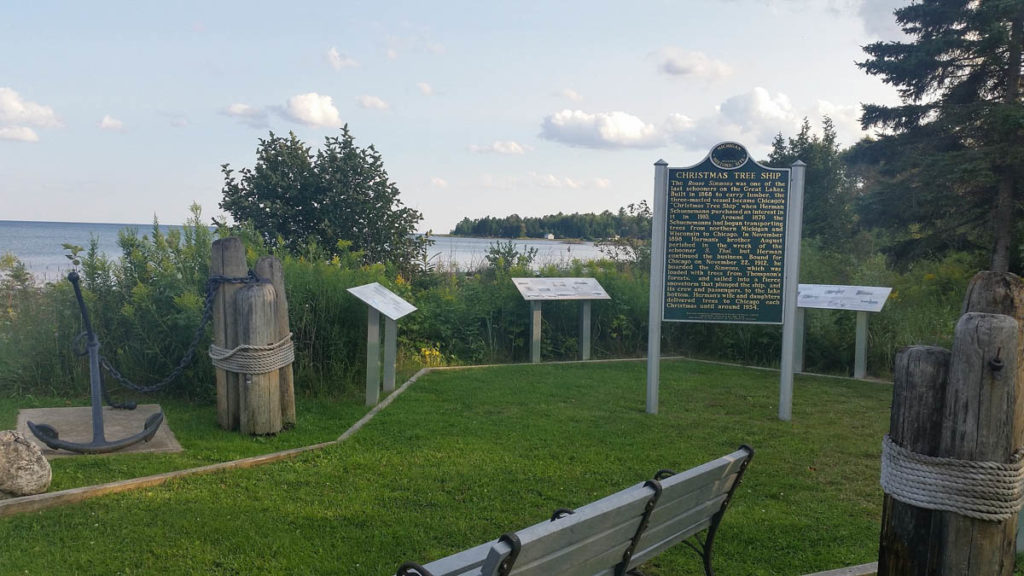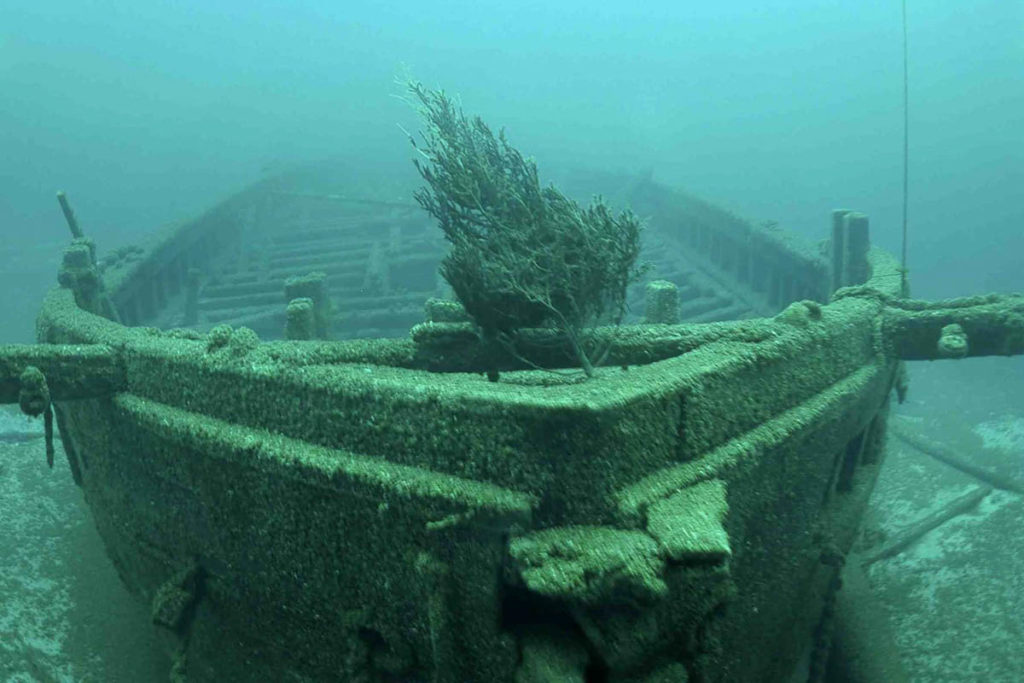The Rouse Simmons aka “The Christmas Tree” was a three-masted schooner known for having sunk in 1912 on Lake Michigan in a violent storm. When it sunk off Two Rivers, Wisconsin, the ship was bound for Chicago with a load of Christmas trees. All hands were lost.
The Rouse Simmons was built by Allan, McClelland, & Company in Milwaukee in 1868 and was named after Rouse Simmons, a Kenosha businessman. The schooner was soon bought by the wealthy lumber magnate of Muskegon, Michigan, Charles H. Hackley, and joined his sizable fleet. Hackley’s vessels worked much of the coastline of Lake Michigan, and for about 20 years, the Rouse Simmons became a workhorse, transporting lumber from company mills to many ports across the lake.
The ship exchanged hands several times following its service to Hackley. Many similar schooners were also sold and became known as “tramp ships”. Herman Schuenemann (Captain Santa) acquired an interest in the ship in 1910, extending it to an eighth in 1912. The other shares were held by Chicago’s Captain Charles Nelson, who owned one eighth and would sail on the fatal voyage alongside Schuenemann. 5,500 trees from Thompson Harbor near Manistique, Michigan, were loaded on the schooner decorated with lights by Schuenemann and the week-long trip to Chicago was underway. His rivals had been prevented from making their own trips by the difficult weather, and snow had covered the tree farms in Michigan and Wisconsin. He hoped that the resulting shortage of Christmas trees would lead to a huge profit and solve his financial problems. With several ships anchoring in port for cover to avoid being battered by the 60 mph winds that could be expected in a November gale on the Great Lakes, the sea conditions of the day were very unfortunate. Local legends claim that the vessel was unseaworthy and that some sailors declined to board the ship. Two years prior to this trip, The Grand Haven Tribune had towed the Simmons schooner to port after it was discovered riding low in the sea. However, the journey started at noon and trees were jammed into every possible corner of the ship. The weight of the trees, particularly in the bad winter weather, was much higher than recommended and definitely contributed to the tragedy.
Two sailors were sent to inspect the lashings on deck during the night, with storms hitting the Simmons hard. A giant wave hit the Simmons with such force that several bundled trees, a small boat and two seamen were swept overboard. Now that the schooner was slightly lighter and more manoeuvrable, it was pointed towards Bailey’s Harbor by Captain Schuenemann. The storms unexpectedly and sadly worsened; ice formed on the sodden trees and the hulls were battered by winds. It was low in the water with tattered sails when the Kewaunee Life Saving Station spotted the Rouse Simmons on November 23, 1912, flying its flag at half-mast signalling that it was in trouble. It was never seen again.
A note in a Rouse Simmons bottle washed up on the shore of Sheboygan, Wisconsin. Using a small piece of a cut pine tree, it had been corked and was the only remains of the vessel found for several years, other than the occasional tree captured in fishing nets.
The message read:
“Friday … everybody goodbye. I guess we are all through. During the night the small boat washed overboard. Leaking bad. Invald and Steve lost too. God help us”
What caused the tragedy that Rouse Simmons suffered? There are some hypotheses, but a combination of factors or events most likely drove the ship down in the heavy seas. The probability that the vessel lost the wheel of its ship in the storm, its poor physical state, heavy icing and snow on the exterior, plus the load of 3,000-5,000 evergreen trees themselves, are among the factors.
Through Schuenemann’s wife Barbara and their two daughters, the Christmas Tree Ship lived on. They preferred to transport the trees by train in the later years, however, and merely used a boat as a platform for sale. The practice of transporting trees by schooner ceased in 1920, and the growing popularity of railways, highways and tree farms soon made it easier and more affordable for anyone to buy a tree.
Scuba diver Gordon Kent Bellrichard from Milwaukee discovered the wreck in 1971 while searching for The Vernon, a 177-foot, the 700-ton steamer that had sunk in a storm in October 1887. Bellrichard was told of an area in which local fishermen had often snagged their nets. He dove down to the lake bed, 172 feet below when his sonar seemed to have located something. Bellrichard managed to survey the wreckage despite his light failing and concluded that he had instead found the Simmons.
Many of the trees are still in the hold of the ship, but two have been removed and exhibited as exhibits. Some objects retrieved from the Rouse Simmons are now stored in the Rogers Street Fishing Village Museum, including the wheel of the ship. The anchor of the ship was recovered and now stands at the entrance to the Milwaukee Yacht Club.
The remnants of the Rouse Simmons are listed on the Historic Places National Register.









